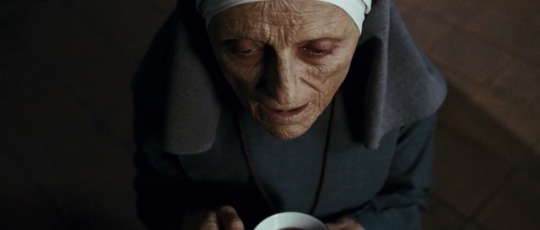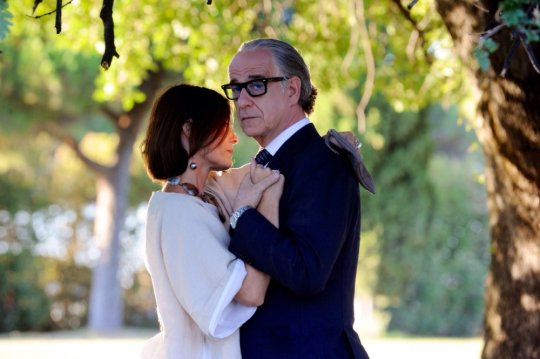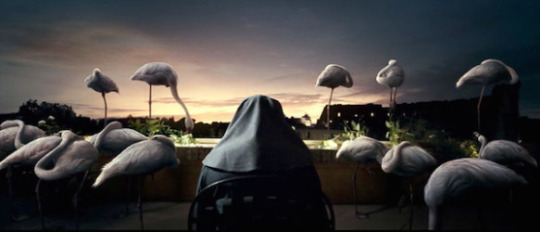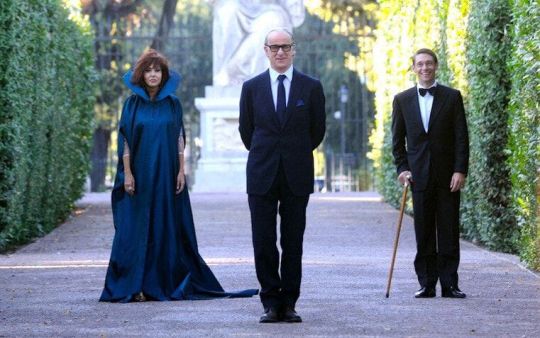#giusi merli
Explore tagged Tumblr posts
Text

Bad movie I have Dune: Part Two 2024
#Dune: Part Two#Timothée Chalamet#Zendaya#Rebecca Ferguson#Javier Bardem#Josh Brolin#Austin Butler#Florence Pugh#Dave Bautista#Christopher Walken#Léa Seydoux#Stellan Skarsgård#Charlotte Rampling#Souheila Yacoub#Roger Yuan#Babs Olusanmokun#Alison Halstead#Giusi Merli#Kait Tenison#Tara Breathnach#Akiko Hitomi#Imola Gáspár#Alison Adnet#Hamza Baissa#Hassan Najib#Jasper Ryan-Cater#Omar Elbooz#Abdelkarim Hussein Seli Mohamed Hassanin#Joseph Beddelem#Xavier Alba Royo
1 note
·
View note
Text
Dune: Part Two (2024) Review
Paul Atreides must unite with Chani and the Fremen whilst also seeking revenge against those who destroyed his family. ⭐️⭐️⭐️⭐️ Continue reading Dune: Part Two (2024) Review

View On WordPress
#2024#Action#Adventure#Alison Halstead#Austin Butler#Babs Olusanmokun#Based on a Novel#Cat Simmons#Charlotte Rampling#Christopher Walken#Cinema#Dave Bautista#Denis Villeneuve#Drama#Dune: Part Two#Dylan Baldwin#Florence Pugh#Frank Herbert#Giusi Merli#Hamza Baissa#Hassan Najib#Hopi Grace#Jasper Ryan-Cater#Javier Bardem#Jon Spaihts#Josh Brolin#Lea Seydoux#Rebecca Ferguson#Review#Roger Yuan
0 notes
Link
0 notes
Text
Dreams Live in Trees Feature 1h53 Country of Origin United Kingdom Directed by: Marco Della Fonte Cast: Kiera Morgan, Pietro Ragusa, Evita Ciri, Rinat Khismautoline, Giusi Merli, Fausto Maria Sciarappa Dreams Live in Trees synopsis https://youtu.be/daqbkHw18_s The story is inspired by true events, which took place in 1978 when Italy became the first country in the world to abolish mental asylums. Upon a closure of a “lunatic asylum” in Florence Anja returns home into the care of her brother Ettore and his wife Lisa. For her family Anja is a difficult woman with mental health problems, who spent most of her life coming in and out of mental institutions. With the help and a great sensitivity from her newly appointed psychiatrist Anja slowly starts to adapt to her new life beyond the asylum. She meets Libero, a local man who delivers vegetables to people in the village. Libero, just like Anja, suffers from mental disorder and learning disabilities. He lives with his mother and is known in the local community as “a crazy murderer”. Years earlier he accidentally killed his father trying to defend his mother. He was arrested and sent to a criminal asylum where he spent a prolonged period of time in isolation. Anja and Libero fall in love. They conduct their relationship under the protection of a secret shack in the middle of the forest surrounded by colored trees, which become the symbol of their love. They face prejudice from Anja’s family and a small town, where they both live. When Anja gets pregnant her family does everything to separate her from Libero and prevent the birth of an "unacceptable" family. An unexpected event brings morality into question. Will Anja and Libero be allowed to keep their baby despite their mental health? Marco Della Fonte Fimography 2020 - DREAMS LIVE IN TREES 2019 - AISA (Short Film) 2019 - A SOUL JOURNEY (Music Drama Documentary) 2016 - NOTHING BY CHANCE - Fashion Short Film (10’) 2015 – REVERSION - Short Film (30')(Selected at Cannes Film Festival 2014 Corner - Best Screenplay Indian Cine Int. Film Festival, Platinum Award at Worldfest Int. Film Festival) 2014 – LAMBORGHINI “THE DRIFT” - Web series(4x6') 2013 – NO NUCLEAR WEAPON - Int. Promo Campaign for UN (3’) 2012 – IEO-European Institute of Oncology - Documentary (25’) 2010 – THE ICE VALLEY - Documentary (7’) 2008 – AWAITING WINTER - Docu-Drama (25’) 2005 – SOLVITE ME - Short Film (8’) 2003 – CHILDREN ARE NOT PATIENT(S) - Docu-Drama (25’) 2002 - SCHIZOPHRENIC BEHAVIOUR - Documentary (40’) 2001 - SPOTTERS - Short Film (3’) 2000 – WANTED: SEX - Short Film (15’) 2000 – HAKERBUK - Disney Channel TV Series (25’) 2000 – PIXEL - Short Film (3’) 1999 – WASH AND DRY - Short film 1998 – THE POLITICIAN - Short Film (8 ‘) 1997 – DIFFERENCE - Short Film (10’) 1997 – OZONE - Short Film (20’) Second Prize Florence Film Festival. 1996 – SAHARAWI: PEOPLE IN EXILE documentary (30’) 1995 – JANNIS KOUNELLIS - Documentary (10’) 1991 – IL MESSAGGERO - Documentary (10’) First Prize Venice Film Fes Cannes 7th Art Awards 2022 International Award – Grand Prize: «Dreams live in trees» by Marco Della Fonte / United Kingdom International Award – Best Director: Marco Della Fonte «Dreams live in trees» / United Kingdom
#Editors_Pick#Fictions#Films#Reviews#Teasers#fictions#films#marco_della_fonte#reviews#UK#united_kingdom
1 note
·
View note
Photo

Lost in Florence (2017) - mehr auf: https://movienized.de/lost-in-florence-2017/
#Abbey Blake#Alessandra Mastronardi#Alessandro Preziosi#Brett Dalton#Emily Atack#Evan Oppenheimer#Giusi Merli#Marco Bonini#Robert Aramayo#Stana Katic
1 note
·
View note
Text
Alluring or Meaningless? - The Ending of Sorrentino’s La Grande Bellezza (The Great Beauty)
Renowned director Paolo Sorrentino's classic 'La Grand Bellezza' mixes the pathos of life with philosophical ideas, but does its ending even have the desired meaning that audiences were expecting?

Giusi Merli in ‘La Grande Bellezza’
Paolo Sorrentino’s renowned 2013 Italian modern classic, ‘La Grande Bellezza’ (The Great Beauty) was certainly one for the critics to praise highly, yet there is a certain quality to its largely masterful storytelling that can see it lacking in true depth. Where much of the film’s entirety soars, its value seems to get lost amongst its artsy attempt to create meaning, where it really can appear as overdone and quite hollow. If we look at the last 30 minutes of Sorrentino’s work, we as an audience can certainly debate whether there is awe-inspiring significance or just overplayed rhetoric in the ending of La Grand Bellezza. Where whimsical characters and moments are introduced, viewers can be very easily swept up in Sorrentino’s foreign fairytale, where it really can be deemed as just pretentious. Yet, this point is far from black and white, as ‘La Grande Bellezza’s’ meaning is up to the audience to interpret, still making it a favoured and beloved work.
Italian director Paolo Sorrentino’s works have garnered praise for their dramatic and striking visuals, as well as their convoluted plots. He has been compared to Federico Fellini, and certainly does seem to take inspiration from the 1960s film icon. But Sorrentino is certainly no copy of Fellini, as his culturally inspired films do reach audiences well. Yet where The Academy Awards gave it the win for Best Foreign Language Film, and where critics seem to kiss it’s feet, this doesn’t always mean that it is altogether an expert piece of cinema. You can say that the beauty of film is that it can be totally subjective, which, in hand, is what makes such great art. So us as an audience can ask whether we view the film as more so pretentious or philosophical?
‘La Grande Bellezza’ follows former writer & popular socialite Jep Gambardella, a sort of philosophical muse for Sorrentino. As Jep’s life in Rome is consumed by materialism, it isn’t until his 65th birthday that he begins to look inwards. This leads him on a search for ‘the great beauty’, which has him relishing in nostalgia and existential simplicity, audiences closely following behind on that journey with him. The greater part of Sorrentino’s film does successfully have us questioning our place in the world, and where our values lie. Through comparing and contrasting the superficial high life with what’s most important to humanity, we are reminded of our own perspectives on what does and should hold the most substance or meaning.

Toni Servillo in 'La Grande Bellezza'
Yet as Jep has wandered around searching in different areas for beauty in truth and philosophy, his defining moment seems to be towards the end of the film, when he is introduced to Saint, Sister Maria. As Jep is told that she had ‘read his novel & loved it’ years before, we are left open to interpretation to who this Saint may be. Yet the answer in itself is somewhat disappointing. Again, it is not to say that the ending of Sorrentino’s film is wrong or terrible, but is surely very thought provoking.
This moment starts in the last thirty minutes of the film, and we are never given a backstory to Sister Maria when or before she is introduced. And she is introduced, literally, on a pedestal. As she sits there in silence, she wears a dusty, grey-blue nun’s habit, her olive skin lined with deep wrinkles, and expression truly dried out. Members of high society kneel to her, kissing her hands. In the chapel that she sits, there are priests, monks, African tribesmen and all in all, only established figures flocking to her, their eyes wide in honour of her presence. It is as though these figures are all awaiting an answer that they cannot find, and seek out from Maria. Though she is established as a wise old prophet with supposed life-changing aid, what makes her so respectable? She appears as though she has lived three lifetimes and has ‘only granted three interviews in all her life’, yet this alleged messiah altogether utters very little meaning. Sister Maria’s introduction has her appearing as a monumental figure, mostly due to the filmmaking aspects of the scene. In the chapel, lit with a chiaroscuro inspired light, along with medieval Roman Catholic music echoing throughout, with the purpose of warming our hearts. Contemplative looks from across the room, including a black priest, may be there to show the diversity that Maria is surrounded by, as those across the globe seem to adore her. The only interpretation gathered is that Sister Maria is an attempt to create a grandiose moment to close out the film in a profound sense. Yet what I’d gathered of this Saint, is that she lives so austerely that Sorrentino’s ending becomes muddled and pretentious.
As previously mentioned, we are never given a backstory to Sister Maria, but maybe that is the beauty of it that Sorrentino was trying to portray. This icon in the film is looked up to for her granted simplicity. But by portraying something so obscure, Sorrentino’s work doesn’t always appear as interesting, but as an attempt to do so. Is it her goodness or her stripped back way of living that those aspire to? And why does it need to be members of high society that only seek her advice? Wouldn’t Sorrentino’s inclusion of ordinary citizens make it all the more realistic, or relatable and grounded, rather than once again getting caught up in something so grand?
Her grandeur is never explained, to which we can be inspired or simply baffled by the mystery, seeing it as something that creates interest, or just remains pretentious. Yet even if her significance was explained, and made this supposed icon as meaningful as someone like the Pope or Mother Teresa, aren’t we supposed to be inspired by the ordinary and the beauty in simplicity. Isn't the point of 'La Grande Bellezza' to celebrate the simple things in life, rather than an established, worshipped figure? The portrayal of this kooky character tries to make a point towards being so well grounded, that it is absurd. As she speaks to Jep, she asks 'Do you know why I only eat roots?', to which Jep asks why, her response following as, 'Because roots are important'. Now Sister Maria's actions line up with her values and grounded nature, as she genuinely decides to eat roots. This can be seen by some as profoundly inspiring, but is altogether quite a weak attempt to deliver an overly-artistic message. And sure, it isn't all pompous, as there is a great reference to the Catholic influences in Italy and the holy hierarchy of Rome & it’s art. But it is the aureate expression doesn’t sell it as being moving, but is instead simply too showy.

When sat down at dinner with Jep and his fellow members of Roman high society, Maria is slouching at the head of the table with a vapid expression. The attempt at meaning that Sorrentino has so clearly tried to create is open to interpretation, yet it can be said that this is not one of the his finest writing moments. Sister Maria does not speak a word, and whenever she does, it is a brooding comment that is supposed to hold substance, but instead can be regarded as pretentious. The moment she lifts her head to comment on Jep's novel, all eyes are so enthusiastically on her. Sister Maria does not sleep in a bed, as she finds Rome’s 5 star Hassler hotel, ‘uncomfortable’. Her perspective on life can be seen as purely existential and somewhat nihilistic, or greatly generous. As she works alongside the sick and supports the Third World, her abandonment of any enjoyment and subscription to poverty has us question our place. Is someone really so empathetic that they’ll refuse any comfort, because others are worse off? Again, Sorrentino does succeed in communicating a message that has us asking questions like this, yet the point is too greatly emphasised through the worshipping and dramatically overdone expression of this holy character.
As Jep focuses on switching his hedonism for eudaemonism, his perspective on the finer things in life is the things he used to have, leading him to relish in nostalgia. Sister Maria seems to be an exaggerated symbol of his changing philosophy, as well as a turning point for him to once again write, after abandoning any such creativity for decades.
Something in meeting Sister Maria has Jep retuning to Giglio Island to report on a shipwreck, again, quite symbolic of Jep’s career position, having not written a novel in 40 years. Here, he remembers his first meeting with his first love, to which inspires him to write again. Apparently Sister Maria is the bridge between Jep’s despair & newfound hope.

Paolo Sorrentino's expertly expressive film is a no doubt a masterful passion project that communicates the pathos and joy of the human condition, impacting audiences greatly. Yet Sorrentino's attempt to create something meaningful to close out an already wonderful film filled it with more vanity than it needed. It is an entirely subjective work that involves the audiences thought and we can all interpret it how we see it, which is assuredly a good thing. However, Sorrentino’s quite bombastic ending was just a questionable cliffhanger and didn't line up with the greatness that the first two hours of 'La Grande Bellezza' provided. Though a fantastic feature, Paolo Sorrentino seemed to get too lost in portraying a message so obscurely overdone, that it had somewhat lost it's original meaning.
visit at: dreamsofthescreen.com
#cinema#writer#blogger#bloggersoftumblr#italianfilm#philosophy#cinemaisnotdead#cinematography#worldcinema#italiancinema#la grande bellezza
3 notes
·
View notes
Text
" Il padre" Alla Corte di Genova
Martedì 13 marzo alle 20.30, al Teatro della Corte va in scena “IL PADRE” di August Strindberg, con Gabriele Lavia protagonista. Lo spettacolo, prodotto dalla Fondazione Teatro della Toscana e dal Teatro Stabile di Genova è diretto da Gabriele Lavia e interpretato anche da Federica Di Martino e da Giusi Merli, Gianni De Lellis, Michele Demaria, Anna Chiara Colombo, Ghennadi Gidari, Luca Pedron. Le scene sono di Alessandro Camera, i costumi di Andrea Viotti, le musiche di Giordano Corapi e le luci di Michelangelo Vitullo. “IL PADRE” è una tragedia che nasce dal tentativo di comporre un’opera “naturalistica”, uno scavo nella natura umana a partire da una semplice dinamica familiare: due genitori si scontrano sull’educazione da impartire alla figlia. Il Capitano di Cavalleria Adolf, icona dell’uomo moderno, lontano da ogni forma di superstizione popolare o religiosa, vorrebbe decidere il destino della figlia adolescente Berta e mandarla a studiare in città, per farla diventare un’insegnante. Sua moglie, donna dal carattere concreto e volitivo, è pronta a tutto per contrastare il volere del marito, persino ad instillare in lui l’atroce dubbio di non essere il padre della ragazza, scatenando nell’uomo un calvario mentale che finirà per annientarlo. Un conflitto di coppia mette così alla berlina la crisi della famiglia borghese, la solitudine umana costretta in dinamiche relazionali rigide, gelide e a lunghi periodi di sofferenza psichica. “IL PADRE” è il testo più famoso di Strindberg e, come lo definì Nietzsche, “Un capolavoro di dura psicologia”. Gabriele Lavia, maestro della scena teatrale, lo affronta per la terza volta nell’arco della sua carriera ed afferma: «L’azione di quest’opera è tutta interiore e stretta nella morsa tragica dell’unità di tempo, luogo e azione nella quale deve essere compiuto il “delitto perfetto”: l’omicidio psichico. Il nostro spettacolo precipita l’azione dentro una vertigine di velluto rosso sangue dove il quieto salotto familiare comincia ad ‘affondare’ nel naufragio di ogni certezza. È il naufragio del mondo e della storia. Ma forse la vita non è altro che un naufragio». “IL PADRE” è in scena al Teatro della Corte da martedì 13 a domenica 18 marzo. Dal martedì al sabato alle ore 20.30. Domenica ore 16. La recita del giovedì inizia alle 19.30. La prima rappresentazione sarà preceduta nel foyer della Corte, alle ore 19,45 da un breve concerto organizzato in collaborazione con il Conservatorio Paganini: musiche tratte E. Grieg - Due Danze norvegesi per pianoforte a quattro mani e da A. Dvorak - Due Danze slave per pianoforte a quattro mani. Al pianoforte Clarissa Carafa e Michele Carraro. L’ingresso al concerto è libero. -------------------------------------- Mercoledì 14 marzo alle ore 17.30, nel foyer della Corte, Gabriele Lavia e gli attori della Compagnia de “IL PADRE” incontrano il pubblico. Conduce Umberto Basevi. Ingresso libero. http://dlvr.it/QKZcrp
1 note
·
View note
Text
Stagione letteraria a Torre Sant'Antonio
New Post has been published on https://calabriawebtv.com/stagione-letteraria-a-torre-santantonio/
Stagione letteraria a Torre Sant'Antonio
Nella splendida cornice dei giardini di Torre Sant’Antonio, antica torre saracena sulla spiaggia del comune di Santa Caterina dello Ionio apre la nuova stagione letteraria 2019.
L’appuntamento fisso del venerdì di quest’anno ha in serbo una serie di inediti e di libri d’autore con un filo comune che è l’amore per la cultura e per il confronto tra le persone.
A partire da Venerdì 25 giugno sarà possibile confrontarsi con una rassegna di autori contemporanei di grande interesse e a seguire, per chi lo desideri, visitare il terrazzo dei merli di Torre Sant’Antonio.
Torre Sant’Antonio è una delle circa 50 Torri Saracene ancora in buono stato facente parte di un più ampio sistema difensivo della nostra costa di circa 350 costruzioni presente anche all’interno del famoso “Codice delle Meraviglie di Romano Carratelli”.
La stagione apre il 25 giugno con lo scrittore Francesco Bevilaqua che presenterà il suo libro “ Fantasticherie di un camminatore errante” attraverso una interessante confronto con Massimiliano Capalbo, creatore del parco avventura “Ombre nel parco”.
A seguire il venerdì successivo l’eclettico autore Walter Lazzarin “Tautogrammi” che ci coinvolgerà con il suo libro e con i suoi esperimenti sulle parola.
I venerdì di Torre Sant’Antonio successivi si arricchiranno di altri autori di sicuro interesse come Ulderico Nisticò, Piergiorgio Iannacaro, Giusy Staropoli, Silvana Franco, Nicola Casile, Alberto Dambruoso, Piergiorgio.
Un modo per stare insieme e riflettere sulla società, sul pianeta che stiamo abitando molto spesso in maniera un po’ incosciente.
“L’amore per lettura e Torre Sant’Antonio sono due mondi strettamente legati fin dal 2010 anno in cui è abbiamo deciso di togliere le televisioni da tutte le stanze del nostro resort e mettere a disposizione dei nostri ospiti una fornita libreria sulla spiaggia” ha dichiarato Marco Badolato gestore di Torre Sant’Antonio
Per rendere più accogliente la serata sarà a disposizione dei partecipanti un servizio di babysitteraggio durante la presentazione del libro.
Per coloro che lo desiderano è possibile prenotare la cena a seguire.
La partecipazione è gratuita previa prenotazione al numero: +393930773954
0 notes
Text
Pinocchi
Al Teatro delle Arti, va in scena il nerissimo racconto a puntate di Collodi, prima dell’imposizione dell’happy ending a fini pedagogici e della melassa disneyana
(more…)
View On WordPress
#Andrea Macaluso#Carlo Lorenzini#Giusi Merli#Lavoratorio#Michele Demaria#Mila Vanzini#Recensione Pinocchi#Teatro Del Carretto#Teatro delle arti#Teatro Popolare d&039;Arte
0 notes
Photo

La grande bellezza (The Great Beauty) | Paolo Sorrentino | 2013
Giusi Merli
17 notes
·
View notes
Text
Accadde oggi
Hei! Niente di personale, cosa pensavate? Solo che sembra che debba accadere tutto questo gioevdì 18 settembre. Io, come al solito, segnalo solo quello che passa nella mia testa, il resto lo trovate su teladoiofirenze. Allora, quest’anno non ho avuto modo di seguire per bene le proposte della rassegna “A Veglia sulle aie di Montespertoli” ma per questa settimana c’è un programma interessante ed è…
View On WordPress
#A veglia sulle aie di Montespertoli#Chianti Fattoria il Turco#Claudia Biondini#Giusi Merli#Podere Torricella fino al 23 settembre#Rosanna Gentili
0 notes
Text
la grande bellezza

Santa: Perché non ha più scritto un libro? Jep: Cercavo la grande bellezza ma… non l’ho trovata.

48 notes
·
View notes